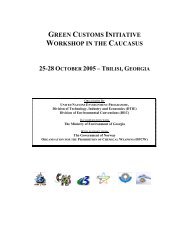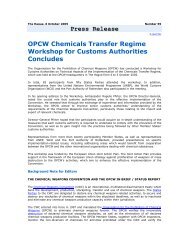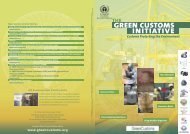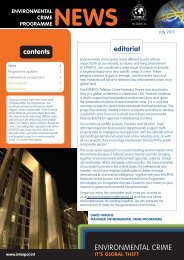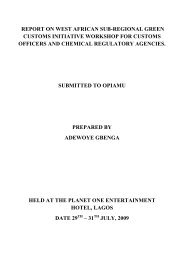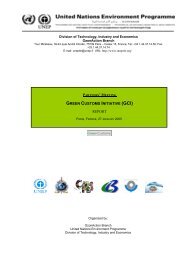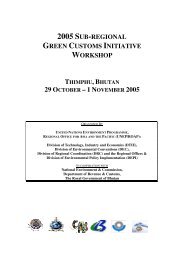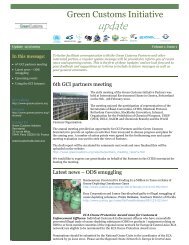Arusha - Green Customs Initiative
Arusha - Green Customs Initiative
Arusha - Green Customs Initiative
Create successful ePaper yourself
Turn your PDF publications into a flip-book with our unique Google optimized e-Paper software.
with the sample document on file, language used on the form itself (English, French or<br />
Spanish), issuing authority matches the authority in the CITES directory, the issuing authority<br />
has signed the document with an original signature and whether the issuing authority’s stamp<br />
or seal is on the document. Mr. Hattenback gave a quick guide as what to look out for with<br />
documentation including: invalid CITES documents (expired, altered, fake, incomplete, copy,<br />
false issuing authority); no match between contents and documents, substitution before<br />
shipping; re-export of contents different than imported; Appendix I commercial purpose; false<br />
captive breeding certificate; false pre-convention claim; false origin/fake issuing authority;<br />
false marking system; and improper shipments to/from non-party country.<br />
He also provided some guidance on safety measures that <strong>Customs</strong> Officers need to observe<br />
such as not opening drums without protective gears, avoiding and/or isolating leaking drums<br />
to a remote storage, consulting hazardous material response personnel whenever necessary<br />
and observing key storage parameters for material. He further outlined a list of important<br />
inspection tools including: I.D. materials, notebook and pen, phone or radio, bags and boxes,<br />
evidence tags & inventory sheets, knife, hammer, pry bar, and camera. Mr Hattenback further<br />
pointed out some of the necessary protective gears including clothing such as gloves<br />
(leather/latex), uniform, coveralls, foot wear (leather/rubber); respirators and shields; and<br />
environmental suits.<br />
Wildlife Smuggling: U.S. Case Studies<br />
Mr. Wayne Hattenbach from the US Department of Justice presented two case studies on<br />
ivory smuggling and trans-boundary smuggling of undersized lobsters. He started describing<br />
the case study on ivory investigation case study which involved smuggling of African<br />
elephant ivory tusks and carved handicrafts from Nigeria to US. The case was jointly<br />
investigated by Service Agents and the U.S. <strong>Customs</strong> Service. He said that the import of a<br />
shipment of handicrafts and furniture arrived at the Port of Los Angeles, California. Following<br />
the discovery of the raw ivory, the Inspector each of the pieces was put on the X-ray machine<br />
revealing ivory hidden inside the fabric of the furniture items, are numerous tusks of elephant<br />
ivory. When the fabric was cut-open, the Inspectors found little pillow padding. As the search<br />
of the shipment continued, pieces of ivory were discovered in each of the items that were<br />
examined. As the investigation A second shipment of ivory was again imported into Los<br />
Angeles, California from Nigeria with ivory smuggled inside statues. This second shipment of<br />
statues was X-rayed and ivory was detected. These statues were opened up and the ivory seen.<br />
However, he explained that the statue shipment was resealed to its original condition upon<br />
import and returned to the air cargo facility. Agents further discovered that the importer of<br />
this shipment was associated with the previous shipment of furniture. Agents search addresses<br />
and previous import records which show both of the smugglers in this case had made many<br />
trips and imports into the U.S. from Nigeria.<br />
Mr. Hattenback indicated that the airline notified the importer that the shipment belonging to<br />
him had arrived at the airport and the Agents planned for a “controlled delivery” of the items<br />
knowing what was inside. He noted that knowledge of the unlawful activity, while not always<br />
required, helped to build the prosecution of the case. The subject arrived at the cargo facility<br />
to pick up the shipments while Agents were watching. After the shipment was picked up,<br />
Agents followed the subject to a storage facility and watched him unloading the shipment into<br />
his storage unit. Agents watched the storage facility 24 hours a day for the next several days.<br />
The subjects were observed loading and manipulating the shipments. Ivory and pieces of the<br />
25



